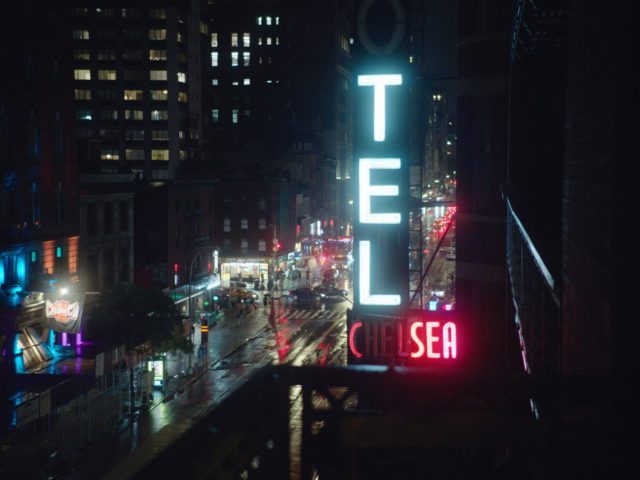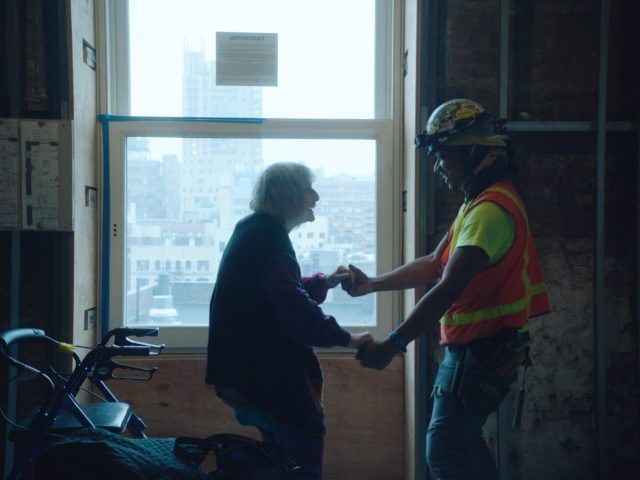
Dreaming Walls explores the legacy of the Chelsea Hotel
DREAMING WALLS: INSIDE THE CHELSEA HOTEL (Amélie van Elmbt and Maya Duverdier, 2022)
IFC Center
323 Sixth Ave. at West Third St.
Opens Friday, July 8
212-924-7771
www.ifccenter.com
“There’s a lot of history in this building. There’s a lot of ghosts around here. Some ghosts, they just die here; some ghosts, they’re really lost, trying to find their way out. But they can’t find it,” a construction worker tells Chelsea Hotel resident and choreographer Merle Lister Levine in the documentary Dreaming Walls: Inside the Chelsea Hotel. The man explains that he searched online for information about the hotel where he was working on major renovations and found out about numerous deaths, including murder and suicide. But he also discovered that “there were a lot of interesting people here, a lot of musicians, a lot of art people, painters.” The two of them, an elderly woman who uses a walker and a strong, vibrant young man, then do the mambo in front of a window that looks out on the city. That, in a nutshell, summarizes both the hotel itself and the documentary.
Built in the 1880s, the Chelsea Hotel (or Hotel Chelsea) has been home to such artists as Dylan Thomas, Patti Smith and Robert Mapplethorpe, William S. Burroughs, Miloš Forman, Sid Vicious, Madonna, and Larry Rivers. Andy Warhol set his 1966 film Chelsea Girls there. It’s where Janis Joplin met Leonard Cohen, leading to Cohen’s song “Chelsea Hotel No. 2.” Others who have connections include Arthur Miller and Marilyn Monroe, the Ramones, Diego Rivera and Frida Kahlo, and Stanley Kubrick. In the film, images of many of these celebrities are occasionally projected onto the chimney and walls as a reminder of what once was.
The documentary, directed by Amélie van Elmbt and Maya Duverdier, alludes to the hotel’s place in the cultural zeitgeist of New York City, but it focuses on the modern-day residents, a group of older people clinging to the Chelsea’s bygone bohemian days as they try to hold on to their apartments following the ouster of longtime manager Stanley Bard and the sale of the hotel to real estate developers in 2011, 2013, and 2016, which left their future in limbo.
Cinematographers Virginie Surdej and Joachim Philippe shoot the film with a faded, muted palette to make it all look old, as if the hotel is haunted by its memories. The effect makes the current residents seem already part of its past, if not its legacy, doomed to be lost souls wandering the hallways as gentrification takes over. This is not the prime heyday of the Chelsea Hotel as a hotbed for creativity.
At one point, architect Nicholas Pappas and his wife, structural engineer Zoe Serac Pappas, the president of the Chelsea Tenants Association who is fighting for the seemingly endless construction to be finished, are lying in bed, discussing the hotel’s link to art. “There are a lot of people going around saying they’re artists, but they don’t do art. And then there comes the question, What is art?” Nicholas points out.

Choreographer Merle Lister Levine dances with a construction worker in Dreaming Walls
The film includes an archival clip of artist and longtime hotel resident Alpheous Philemon Cole, once the world’s oldest man, being asked what’s wrong with modern art. “Everything,” he responds. In a recent interview with painter Bettina Grossman, the oldest person in the building, she says, “Everybody else was paid to leave, and they did not offer me any money to go. So I’m thinking, maybe they prefer to kill me. . . . They do things to frighten me out.”
Duverdier and van Elmbt don’t delve deeply into the troubles the hotel has experienced this century; they don’t seek comment from the current owners or anyone involved in the construction, which goes on right around the residents, as if they’re already not there.
“For a long time I felt like I was witnessing a slow-motion rape of this building,” multimedia artist Steve Willis, who lives in Joplin’s old suite, explains. “I’m not watching it anymore. I’m not participating. I’ll show up in court and say I saw it happen, but that’s it. The last straw was giving up a large chunk of my apartment here.”
Perhaps the most important line in the film, which is executive produced by Martin Scorsese and opens July 8 at IFC Center, comes from artist Rose Cory, who says, “I live a very unusual life here.”